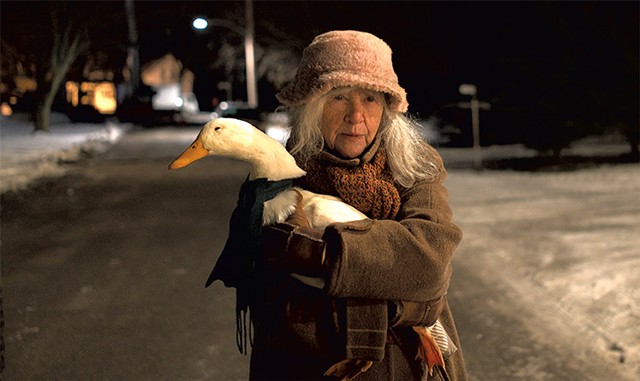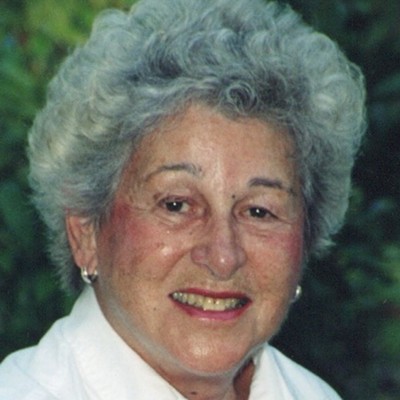
- Courtesy Of Amazon
- Coulter's duck-toting poet is one of many colorful characters who populate the truncated TV adaptation of Penny's mystery novels.
Unlike Vermont, Québec is a film hub: Hollywood movies ranging from The Notebook to Scream VI to John Wick: Chapter 2 were shot on Montréal's soundstages. Most of the international productions filmed in Québec aren't set there. But one notable exception is "Three Pines," Prime Video's adaptation of Louise Penny's best-selling mystery series that takes place in the Eastern Townships.
For picturesque exteriors of the eponymous village, the crew went to Saint-Armand, near the Vermont border. (The area that actually inspired Penny's Three Pines is farther north; see "A World of Curiosities.") An eight-episode season of the series, created by Emilia di Girolamo, premiered in December 2022. As is so often the case in the brave new streaming world, "Three Pines" was canceled just a few months later, leaving viewers on a never-to-be-resolved cliff-hanger.
The deal
After a young Mohawk woman goes missing, her friends and family protest outside the headquarters of the Sûreté du Québec, the provincial police force. Chief homicide inspector Armand Gamache (Alfred Molina) befriends the woman's family and devotes himself to finding her.
Vexed by his insubordination, Gamache's superiors send him to investigate a murder in the tiny town of Three Pines. The place is home to an excellent bistro, a bookstore and a gallery of eccentrics, including a renowned elderly poet (Clare Coulter) who swears like a sailor and is never without her pet duck.
The series encompasses four self-contained mysteries, each two episodes long, with the missing Mohawk woman as a thread linking them. Gamache must solve the cases of the wealthy poseur who was electrocuted during the Boxing Day curling match; the man who died in a supposedly haunted former residential school; the hotel heiress who ran afoul of her whole family; and the John Doe found hanging from a tree.
Will you like it?
Though I haven't read Penny's books, I gather from their fans that "Three Pines" is far from a faithful adaptation. Characters have been changed, plots rearranged and sometimes created wholesale. In a Facebook post, Penny herself objected to a line in the show describing Three Pines as a place that "chases out" unwanted intruders. "It makes me wonder if they understand the heart and soul of the village," she wrote. "Three Pines is the soft landing, the open arms, the place at the table."
Did the show's creators attempt to impose the sinister atmosphere of "Twin Peaks" or "Top of the Lake" on a fictional town that was conceived as less weird and more welcoming? After watching eight episodes, I'm not sure even they knew what they were going for.
The chief inspector gives the series a strong moral center: Molina makes him an impeccably affable, decent fellow with a likably rumpled exterior. But Gamache lives in Montréal, and he's still a tourist in Three Pines by the series' end. Viewers may feel similarly like outsiders, because we never get a strong sense of the town's inner workings. Twee traditions such as the annual curling match clash with darker motifs such as the former residential school for Indigenous children, which represents a shameful episode in Canada's history.
Three Pines is full of folks who make excellent murder suspects: some perpetually gruff, others petulant, all possessed of murky pasts. I appreciated the bursts of local color — for instance, characters switching effortlessly back and forth from English to Québécois French. But we don't get to know any of these people well enough to love them, and too many of their portrayals are one-note.
Caricatures can be fun, of course. The pair of episodes devoted to the heiress' murder — set in a luxury hotel outside Three Pines — works fine as a campy riff on Agatha Christie, a poor man's Knives Out.
But the only supporting character I really wanted to see more of was Bea Mayer, owner of the town's gallery and Indigenous cultural center, played by veteran Cree actor Tantoo Cardinal. Her quietly expressive performance hints at a wealth of experience — and secrets.
It's fashionable nowadays for fictional detectives to have unresolved childhood trauma. The show spends a fair bit of time exploring Gamache's through arty flashbacks involving a bluebird motif. But these dives into the past are only tenuously connected to the central mystery (the missing woman is named Blue), and they don't reveal much about our protagonist that we didn't already know.
"Three Pines" feels like a series that was never allowed to hit its stride. Over more episodes, the characters might have gained depth, and the town might have emerged as the lovable oasis that Penny imagined. Left frustratingly incomplete, the series did accomplish one thing: It whetted my appetite for the source material.










Comments
Comments are closed.
From 2014-2020, Seven Days allowed readers to comment on all stories posted on our website. While we've appreciated the suggestions and insights, right now Seven Days is prioritizing our core mission — producing high-quality, responsible local journalism — over moderating online debates between readers.
To criticize, correct or praise our reporting, please send us a letter to the editor or send us a tip. We’ll check it out and report the results.
Online comments may return when we have better tech tools for managing them. Thanks for reading.